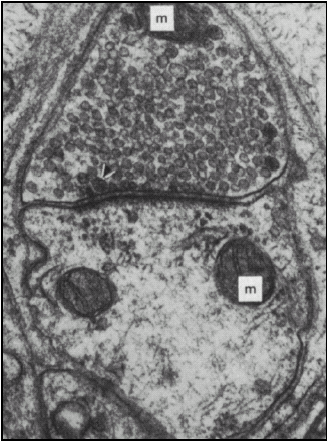
Drugs Change the Way
Neurons Communicate
Lesson 3

From: Principles of Neural Science, Third edition, Eric R. Kandel, James H. Schwartz, Thomas M. Jessell ©The McGraw-Hill Companies. (m = mitochondria)
Drugs Disrupt Neurotransmission
How do drugs cause their effects on the brain and behavior? Lesson 1 introduced students to the idea that a specific brain region, the reward system (part of the limbic system), regulates feelings of pleasure and that this region is activated by drugs of abuse. But what do drugs actually do in that brain region? Drugs interfere with neurotransmission. More specifically, drugs of abuse produce feelings of pleasure by altering neurotransmission by neurons in the reward system that release the neurotransmitter dopamine.1, 2 Thus, rugs of abuse alter the communication between neurons that is mediated by dopamine. Because the synapse is so complex, there are a variety of sites at which drugs may affect synaptic transmission. One way to affect synaptic transmission is to increase the amount of neurotransmitter that is released into the synaptic space. Drugs like alcohol, heroin, and nicotine excite the dopamine-containing neurons in the ventral tegmental area (VTA) so that they produce more action potentials.1, 2 As the number of action potentials increases, so does the amount of dopamine released into the synapse. Amphetamines (e.g., methamphetamine, crystal, crank) actually cause the release of dopamine from the vesicles. This is independent of the rate of action potentials and, depending on dose, can cause a relatively quick and prolonged rise of extracellular dopamine levels. Nicotine not only acts at the cell body in the VTA to increase the number of action potentials and number of vesicles released from a neuron, but it also acts
by another mechanism to alter dopamine release. When nicotine binds to nicotine receptors on the dopamine-containing axon terminals in the nucleus accumbens, more dopamine is released with each action potential.
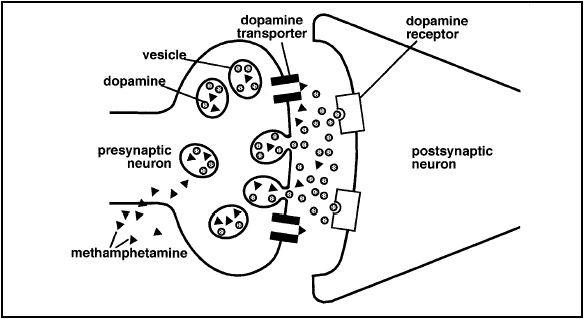
Figure 3.1: Methamphetamine alters dopamine neurotransmission in two ways. Methamphetamine enters the neuron by passing directly through nerve cell membranes. It is carried to the nerve cell terminals by transporter molecules that normally carry dopamine or norepinephrine. In the nerve terminal, methamphetamine enters the dopamine- or norepinephrine-containing vesicles and causes the release of neurotransmitter. Methamphetamine also blocks the dopamine transporter from pumping dopamine back into the transmitting neuron. Methamphetamine acts similarly to cocaine in this way.
Drugs may also alter synaptic transmission by directly affecting the postsynaptic receptors. Some drugs activate receptors and others block them. While THC (the main psychoactive chemical in marijuana) and morphine activate their specific receptors, other drugs block specific receptors. Caffeine, the mild stimulant found in coffee and some soft drinks, exerts its effects by preventing a neurotransmitter/neuromodulator called adenosine from binding to its receptor. Normally, the binding of adenosine to its receptor causes sedation; it is a natural sleep-inducer. Instead of causing sedation, the blocking of the adenosine receptors with caffeine leads to an increase in activity and arousal levels.
The actions of some drugs are very complex. LSD, for example, acts on serotonin receptors. Serotonin, an important neurotransmitter in many brain regions, is involved in regulating a wide variety of functions, including mood and basic survival functions such as sleep and eating. Scientists continue to study how hallucinogens act, but apparently LSD activates some serotonin receptors (LSD acts as a receptor agonist) and blocks other serotonin receptors (LSD acts as a receptor antagonist). A third way to affect synaptic transmission is to alter the removal of neurotransmitters from the synapse. Cocaine and amphetamines work this way (this is the second way in which amphetamines can alter neurotransmission). Both drugs block the dopamine transporter (reuptake pump) that removes dopamine from the synapse. The result is a fairly rapid rise of dopamine in the synapse, leading to feelings of euphoria and well-being. There are no drugs of abuse that block enzymatic destruction of neurotransmitters, although some antidepressants work by this mechanism.
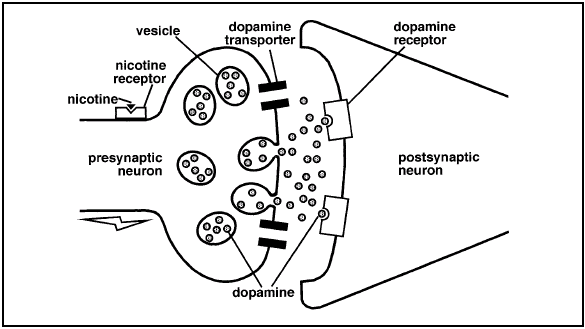
Figure 3.2: Nicotine binds to specific receptors on the presynaptic neuron. When nicotine binds to receptors at the cell body, it excites the neuron so that it fires more action potentials (electrical signals) that move toward the synapse causing more dopamine release (not shown in figure). When nicotine binds to nicotine receptors at the nerve terminal (shown above), the amount of dopamine released in response to an action potential is increased.
Drugs of abuse share a common action: they act on the brainís reward system. Within that system, they all (except perhaps for LSD) share the ability to increase the levels of dopamine in the nucleus accumbens. This almost certainly accounts for the rewarding (pleasurable) effects of abused drugs. The effects of drugs are not limited to the reward pathway in the brain. Drugs can act in various regions of the brain to exert their effects, but their ability to alter dopamine neurotransmission in the ventral tegmental area (VTA) and the nucleus accumbens is one of the most important factors that drives continued drug use.

Figure 3.3: When cocaine enters the brain, it blocks the dopamine transporter from pumping dopamine back into the transmitting neuron, flooding the synapse with dopamine. This intensifies and prolongs the stimulation of receiving neurons in the brainís pleasure circuits, causing a cocaine "high."
Drugs Mimic Natural Body Chemicals
The ability of drugs to interrupt normal synaptic transmission may seem odd. After all, if receptors have such great specificity for a single type of binding partner, how can drugs disrupt the process? The answer lies in the similarity in conformation, or structure, of the drugs to natural body chemicals. For example, the receptors that bind morphine and other opiates are expressed in the brain to recognize natural opioid peptides called endorphins and enkephalins that are made by our brains and used as neurotransmitters.4 It is an evolutionary coincidence that these receptors recognize a plant-derived chemical (drug) as well. This coincidence is a double-edged sword. Opiate compounds that come from plants are both the most potent analgesics (pain relievers) available and some of the most potent addictive drugs as well. Morphine continues to be one of the most effective drugs to relieve the pain associated with many chronic diseases. The doses of opiates used by addicts simply overwhelm the opiate receptors in the VTA and nucleus accumbens and cause profound feelings of pleasure (euphoria). Tetrahydrocannabinol (THC), the active ingredient in marijuana, binds to receptors in the brain that are specific for anandamide, an endogenous chemical that is similar in structure to THC. Because THC is similar in structure to anandamide, it binds to the same receptor. Scientists do not yet fully understand anandamideís function in the body, but it may play a role in memory functions. Marijuana disrupts short-term memory in humans. Anandamide may be involved in eliminating unneeded information from memory, but much remains to be learned before its functions are understood. Other studies indicate anandamine in an area of the brain called the dorsal striatum inhibits movements that are stimulated by dopamine.5 This finding may enable scientists to develop medications for treating diseases such as schizophrenia, Gilles de la Tourette syndrome, or Parkinsonís disease. Each of these diseases involves dopamine imbalances in the brain.
The Dose Changes the Drugís Effects
For drugs to exert their effects, a person must take them into the body and absorb them into the bloodstream. Some of these effects relate to the amount of the drug taken. For example, at low doses no effect (or response) can be observed or measured. Once a certain amount of the drug enters the bloodstream, a response can then be measured. This point is known as the threshold. At doses of the drug below the threshold amount, there is too little of the drug in the body to cause neurons to be activated. For example, there may not be enough heroin in the body to bind to opiate receptors in sufficient amounts to cause a change in neuronal activity. As the amount of drug taken increases, so does the response. A response cannot continue to increase infinitely, however. At some point, the response to a given amount of drug will reach a plateau, or a maximum level. To continue our example, when levels of opiates are very high in the blood, many opiate receptors have heroin bound to them and the neurons are already activated; no additional activation is possible. At higher doses, opiates are toxic and can cause a fatal response by halting respiration.
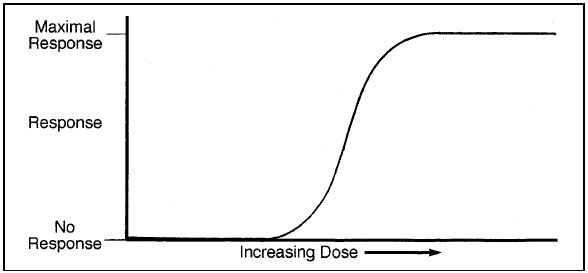
Figure 3.4: When the dose of a drug is low, no response is measurable. As the dose increases, the effect of the drug increases until it reaches a maximum. At high doses, the response to the drug remains at the maximum level.
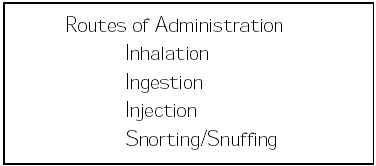
Figure 3.5: Drugs enter the bloodstream by one of four routes of administration.
Routes of Administration
Inhalation
Ingestion
Injection
Snorting/Snuffing
The dose is not the only factor that changes the effects that a drug causes in the body. The same amount or dose of a drug can lead to milder or more severe responses depending on how the drug enters the body.1, 4 A drug that is inhaled (smoked) reaches the brain very quickly. The inhaled drugs go directly from the lungs into the left side of the heart where they enter the arterial circulation that carries them to the brain. Marijuana and nicotine are examples of drugs that are commonly taken into the body by inhalation (smoking). The intensity of the effect of inhaled drugs may be slightly less than that for injected drugs because less of the drug is taken into the body; some of the drug will be exhaled with the rest of the components of the smoke. A drug that is injected intravenously also travels quickly to the brain where it can exert its effects. The rapid passage of injected heroin, for example, brings a high risk of overdose. The heroin in the blood can reach lethal levels much faster than medical help could possibly be obtained. A third route of drug administration is by snorting or snuffing. A drug that is snorted or snuffed is taken in through the nose where it is absorbed through the mucous membranes lining the nasal passages. Television and movies often depict cocaine being snorted. The effects of drugs taken by this method will be less intense than by injection or inhalation because it takes longer for the drug to get into the bloodstream and because it does not enter the blood as efficiently. The fourth route of administration is by oral ingestion. Most people are familiar with taking a medicine, either as a solid or a liquid, by mouth. People can also take drugs of abuse this way. Drugs commonly taken orally include stimulants and depressants. Drugs taken orally enter the bloodstream more slowly than by any of the other routes. The drugs pass through the digestive tract until they reach the stomach and intestine where they are absorbed into the bloodstream. Not only do they take longer to act, but the body begins to metabolize them before they can act on the brain. Enzymes in the stomach, intestines, and liver begin breaking down the drugs so they can be cleared from the body.
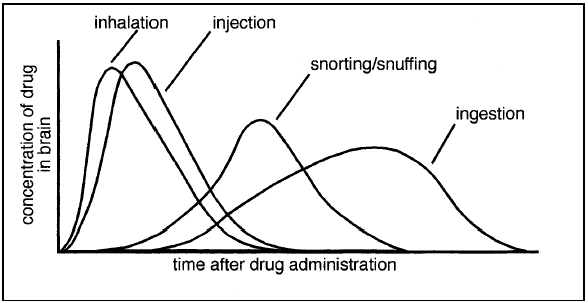
Figure 3.6: Drugs of abuse enter the body by different routes. The intensity of a drugís effect depends on how the drug is taken.
This material is based on work supported by the National Institutes of Health under Contract No: 263-98-C-0056. Any opinions, findings, conclusions, or recommendations expressed in this publication are those of the authors and do not necessarily reflect the view of the funding agency.
Copyright c 2000 by BSCS and Videodiscovery, Inc. All rights reserved. You have the permission of BSCS and Videodiscovery, Inc. to reproduce items in this module (including the software) for your classroom use. The copyright on this module, however, does not cover reproduction of these items for any other use. For permissions and other rights under this copyright, please contact BSCS, 5415 Mark Dabling Blvd., Colorado Springs, CO 80918-3842, www.bscs.org, info@bscs.org, (719) 531-5550.
NIH Publication No. 00-4871
ISBN: #1-929614-05-5